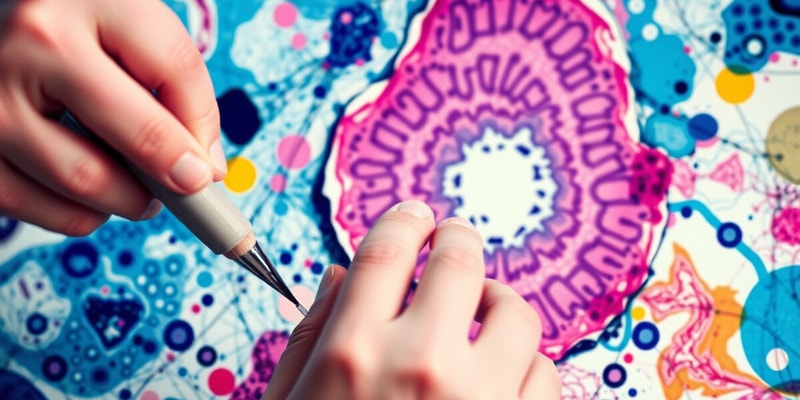Podcast
Questions and Answers
What is the first step in studying body tissues according to the provided content?
What is the first step in studying body tissues according to the provided content?
Which type of microscope is mentioned in the context of studying body tissues?
Which type of microscope is mentioned in the context of studying body tissues?
What is the purpose of microtechniques in histology?
What is the purpose of microtechniques in histology?
Considering the study of body tissues, which of the following steps follows specimen preparation?
Considering the study of body tissues, which of the following steps follows specimen preparation?
Signup and view all the answers
In histology, what is a primary aim of using microscopy?
In histology, what is a primary aim of using microscopy?
Signup and view all the answers
What is the first step in preparing a specimen for light microscope examination?
What is the first step in preparing a specimen for light microscope examination?
Signup and view all the answers
Which of the following steps is directly related to enhancing the visibility of cellular structures for a light microscope?
Which of the following steps is directly related to enhancing the visibility of cellular structures for a light microscope?
Signup and view all the answers
What is NOT a common step involved in the preparation of specimens for light microscopy?
What is NOT a common step involved in the preparation of specimens for light microscopy?
Signup and view all the answers
When preparing a specimen for examination under a light microscope, what is the purpose of staining?
When preparing a specimen for examination under a light microscope, what is the purpose of staining?
Signup and view all the answers
Which stage follows preparing a tissue section in the light microscope specimen preparation process?
Which stage follows preparing a tissue section in the light microscope specimen preparation process?
Signup and view all the answers
What does the routine stain Hematoxylin and eosin (H&E) primarily identify in tissues?
What does the routine stain Hematoxylin and eosin (H&E) primarily identify in tissues?
Signup and view all the answers
Which of the following components is considered basophilic when stained with H&E?
Which of the following components is considered basophilic when stained with H&E?
Signup and view all the answers
Which statement about acidophilic staining in H&E is correct?
Which statement about acidophilic staining in H&E is correct?
Signup and view all the answers
In histology, which counterpart is matched with acidophilic when using H&E?
In histology, which counterpart is matched with acidophilic when using H&E?
Signup and view all the answers
What primary function do special stains serve in histological analysis?
What primary function do special stains serve in histological analysis?
Signup and view all the answers
What is the primary function of a Transmission Electron Microscope (TEM)?
What is the primary function of a Transmission Electron Microscope (TEM)?
Signup and view all the answers
In electron microscopy, what is characteristic of electron dense granules?
In electron microscopy, what is characteristic of electron dense granules?
Signup and view all the answers
What type of image does a Scanning Electron Microscope (SEM) primarily provide?
What type of image does a Scanning Electron Microscope (SEM) primarily provide?
Signup and view all the answers
Which of the following statements about electron lucent granules is true?
Which of the following statements about electron lucent granules is true?
Signup and view all the answers
How do the functionalities of TEM and SEM differ?
How do the functionalities of TEM and SEM differ?
Signup and view all the answers
Study Notes
Microtechniques & Microscopy
- Histology is the study of tissues.
- The study of tissue requires preparation of a specimen and microscopy.
Light Microscope (LM)
- Two main types of microscopes are used in histology: Light Microscope (LM) and Electron Microscope (EM).
- The LM is used to view biological specimens at a magnified scale.
- A tissue section is prepared for viewing under the LM.
- The tissue section is stained with dyes to enhance visibility of the cells and structures.
- Hematoxylin and eosin (H&E) is the most common stain used in histology.
- Hematoxylin stains basophilic structures blue or purple, such as nuclei and cytoplasm.
- Eosin stains acidophilic structures pink or red, such as cytoplasm and some extracellular structures.
Electron Microscope (EM)
- The Electron Microscope (EM) offers higher resolution than the LM, allowing visualization of intracellular details.
- There are two types of EM: Transmission Electron Microscope (TEM) and Scanning Electron Microscope (SEM).
- The TEM allows visualization of internal structures of cells, while the SEM gives a 3D image of the surface.
- Electron dense granules appear darker in electron microscopic images, while electron lucent granules appear lighter.
Studying That Suits You
Use AI to generate personalized quizzes and flashcards to suit your learning preferences.
Related Documents
Description
Explore the fundamentals of histology and microscopy in this quiz. Learn about the preparation of tissue specimens, the use of light and electron microscopes, and the importance of staining techniques such as H&E. Test your knowledge on the key differences between Light Microscopes (LM) and Electron Microscopes (EM).




